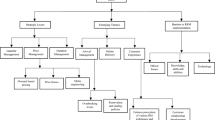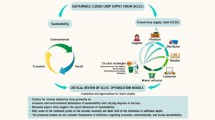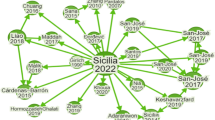Abstract
Models for the optimal location of retail facilities are typically premised on current market conditions. In this paper we incorporate future market conditions into the model for the location of a retail facility. Future market conditions are analyzed as a set of possible scenarios. We analyze the problem of finding the best location for a new retail facility such that the market share captured at that location is as close to the maximum as possible regardless of the future scenario. The objective is the minimax regret which is widely used in decision analysis. To illustrate the models an example problem is analyzed and solved in detail.
Similar content being viewed by others
References
Anderson, D. R., Sweeney, D. J., & Williams, T. A. (1994). An introduction to management science (7th ed.). Minneapolis: West Publishing.
Converse, P. D. (1949). New laws of retail gravitation. Journal of Marketing, 14, 379–384.
Drezner, T. (1994). Optimal continuous location of a retail facility, facility attractiveness, and market share: an interactive model. Journal of Retailing, 70, 49–64.
Drezner, T. (1995a). Competitive location in the plane. In Z. Drezner (Ed.), Facility location: a survey of applications and methods. New York: Springer.
Drezner, Z. (1995b). In Z. Drezner (Ed.), Facility location: a survey of applications and methods. New York: Springer.
Drezner, Z. (1995c). Replacing discrete demand with continuous demand. In Z. Drezner (Ed.), Facility location: a survey of applications and methods. New York: Springer.
Drezner, T., & Drezner, Z. (1997). Replacing discrete demand with continuous demand: the impact on optimal facility location. Naval Research Logistic, 44, 81–95.
Drezner, T., & Drezner, Z. (1998a). Facility location in anticipation of future competition. Location Science, 6, 155–173.
Drezner, Z., & Drezner, T. (1998b). Applied location theory methods. In G. A. Marcoulides (Ed.), Modern methods for business research. Mahwah: LEA Associates.
Drezner, T., & Drezner, Z. (2002a). Validating the gravity-based competitive location model using inferred attractiveness. Annals of Operations Research, 111, 227–237.
Drezner, T., & Drezner, Z. (2002b). Retail facility location under changing market conditions. IMA Journal of Management Mathematics, 13, 283–302.
Drezner, T., & Drezner, Z. (2004). Finding the optimal solution to the Huff competitive location model. Computational Management Science, 1, 193–208.
Drezner, Z., & Guyse, J. (1999). Application of decision analysis techniques to the Weber facility location problem. European Journal of Operational Research, 116, 69–79.
Drezner, Z., & Suzuki, A. (2004). The big triangle small triangle method for the solution of non-convex facility location problems. Operations Research, 52, 128–135.
Drezner, Z., & Wesolowsky, G. O. (1991). Facility location when demand is time dependent. Naval Research Logistics, 38, 763–777.
Drezner, T., Drezner, Z., & Shiode, S. (2002). A threshold satisfying competitive location model. Journal of Regional Science, 42, 287–299.
Eiselt, H. A., Laporte, G., & Thisse, J.-F. (1993). Competitive location models: a framework and bibliography. Transportation Science, 27, 44–54.
Fernández, J., & Pelegrin, B. (2001). Using interval analysis for solving planar single-facility location problem: new discarding tests. Journal of Global Optimization, 19, 61–81.
Fernández, J., Pelegrin, B., Plastria, F., & Tóth, B. (2003) Location and design of a new facility under proportional and partially binary customers’ preferences. In EWGLA 14, Corfu, Greece, September 2003.
Fourer, R., Gay, D. M., & Kernighan, B. W. (1993). AMPL—a modeling language for mathematical programming. South San Francisco: Scientific Press.
Ghosh, A., & Craig, C. S. (1983). Formulating retail location strategy in a changing environment. Journal of Marketing, 47, 56–68.
Ghosh, A., & McLafferty, S. L. (1987). Location strategies for retail and service firms. Lexington: Lexington Books.
Ghosh, A., McLafferty, S. L., & Craig, C. S. (1995). Multifacility retail networks. In Z. Drezner (Ed.), Facility location: a survey of applications and methods. New York: Springer.
Hakimi, S. L. (1983). On locating new facilities in a competitive environment. European Journal of Operational Research, 12, 29–35.
Hakimi, S. L. (1990). Locations with spatial interactions: competitive locations and games. In R. L. Francis & P. B. Mirchandani (Eds.), Discrete location theory (pp. 439–478). New York: Wiley-Interscience.
Hansen, P., Peeters, D., Richard, D., & Thisse, J.-F. (1985). The minisum and minimax location problems revisited. Operations Research, 33, 1251–1265.
Hillier, F. S., & Lieberman, G. J. (1990). Introduction to operations research (5th ed.). New York: McGraw-Hill.
Hotelling, H. (1929). Stability in competition. Economic Journal, 39, 41–57.
Huff, D. L. (1964). Defining and estimating a trading area. Journal of Marketing, 28, 34–38.
Huff, D. L. (1966). A programmed solution for approximating an optimum retail location. Land Economics, 42, 293–303.
Nakanishi, M., & Cooper, L. G. (1974). Parameter estimate for multiplicative interactive choice model: least squares approach. Journal of Marketing Research, 11, 303–311.
Plastria, F. (1992). GBSSS: The Generalized Big Square Small Square method for planar single facility location. European Journal of Operational Research, 62, 163–174.
Plastria, F. (2001). Static competitive facility location: an overview of optimisation approaches. European Journal of Operational Research, 129, 461–470.
Plastria, F. (2002). Formulating logical implications in combinatorial optimisation. European Journal of Operational Research, 140(2), 338–353.
Plastria, F. (2003). Models for competitive location with foresight. In S. Singh, D. K. Nayak & B. S. Mipun (Eds.), Proceedings international conference on environment, locational decisions and regional planning. Shillong, India (pp. 27–37). Shillong: The Geographical Society of North–Eastern Hill Region.
Plastria, F., & Vanhaverbeke, L. (2004) Discrete models for competitive location with foresight. In EWGLA 15, Saarbreucken, Germany, September 2004.
Prescott, E. C., & Visscher, M. (1977). Sequential location among firms with foresight. Bell Journal of Economics, 8, 378–393.
Serra, D., & Marianov, V. (1999). The p-median problem in a changing network: the case of Barcelona. Location Science, 6, 383–394.
Serra, D., Ratick, S., & ReVelle, C. (1996). The maximum capture problem with uncertainty. Environment and Planning B, 23, 49–59.
Serra, D., & ReVelle, C. (1994). Market capture by two competitors: the preemptive capture problem. Journal of Regional Science, 34, 549–561.
Serra, D., & ReVelle, C. (1995). Competitive location in discrete space. In Z. Drezner (Ed.), Facility location: a survey of applications and methods. New York: Springer.
Simpson, P. (1969). On defining areas of Voter choice. Quarterly Journal of Economics, 83, 478–487.
Reilly, W. J. (1931). The law of retail gravitation. New York: Knickerbocker.
Author information
Authors and Affiliations
Corresponding author
Rights and permissions
About this article
Cite this article
Drezner, T. Location of retail facilities under conditions of uncertainty. Ann Oper Res 167, 107–120 (2009). https://doi.org/10.1007/s10479-007-0253-6
Published:
Issue Date:
DOI: https://doi.org/10.1007/s10479-007-0253-6




